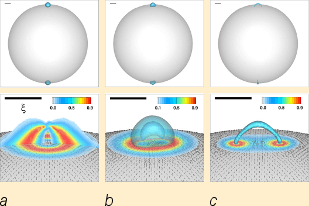Research Investigação
Nematic films on patterned surfaces: Distorsion-guided assembly of colloidal particles

Three types of boojum core structures: (a) single-core, (b) doublecore and (c) split-core configurations.
We will study the interplay between nematic elasticity and surface heterogeneity with the goal of guiding the assembly of colloidal particles, dispersed in nematics, into large scale colloidal crystals. Because of the size of the colloids the system spontaneous self-assembly is limited to small crystallites. One promising route is template-directed colloidal self-assembly. This uses structures on a solid surface as templates that promote the nucleation and growth of well-defined crystal structures. The method has been implemented for isotropic colloids and it has proved to be an easy, robust, highly efficient and scalable.
We will address surface ordering of colloids characterized by long-ranged anisotropic effective interactions, such as nematic colloids. The effective interactions arise from the long-range distortions of the nematic director. Nematic colloids have been studied intensively, mostly in the bulk, i.e., far from bounding surfaces, or at planar bounding surfaces imposing uniform anchoring. Non-uniform bounding surfaces promote long range director distortions acting as an ordering external potential for the dispersed colloidal particles. This ordering potential is controlled through the surface pattern using conventional microfabrication techniques such as, e.g., soft lithography. Moreover, the effective surface-particle interactions may be tuned by changing the anchoring properties of the surface, the liquid crystal, the temperature and external electric or magnetic fields.
We will investigate the behavior of nematic colloids close to patterned surfaces. We consider both chemically and geometrically patterned surfaces. The nematic solvent is modeled in the framework of Landau-de Gennes theory. Colloids and surfaces impose either homeotropic or degenerate tangential anchoring. The Landau-de Gennes free energy will be minimized using finite elements with adaptive meshing.
References
- Interactions of distinct qudrupolar nematic colloids, Z. Eskandari, N. M. Silvestre, M. Tasinkevych, and M. M. Telo da Gama, Soft Matter 8, 10100 (2012).
- Liquid Crystals Boojum-Colloids, M. Tasinkevych, N. M. Silvestre and M. M. Telo da Gama, New Journal of Physics 14, 073030 (2012).
